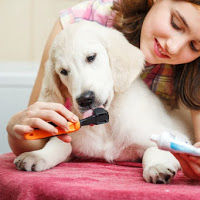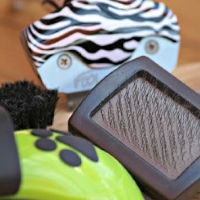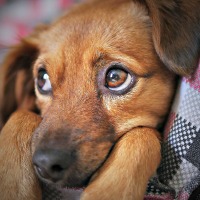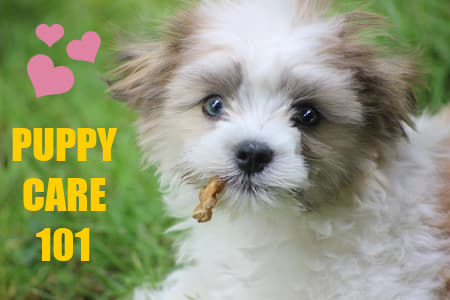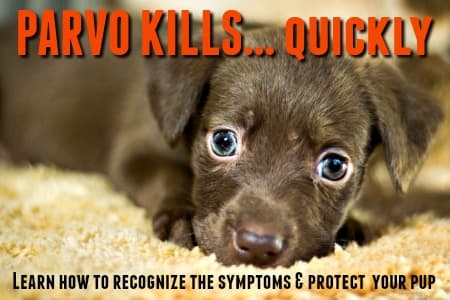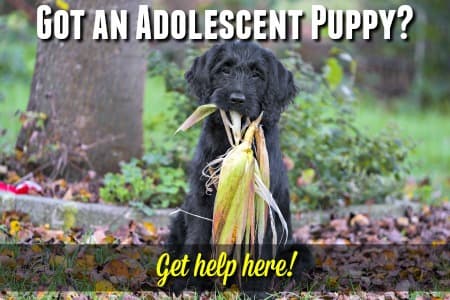FYI: If you buy something through a link on this site I may earn a commission - at NO extra cost to you.
Bathing A Puppy...
Bathing a puppy isn't always going to be an optional activity because puppies can get dirty, sticky and smelly at the drop of a hat!
Their endless curiosity will get them into all sorts of 'stuff' on a regular basis, and sooner or later a bath is going to be essential.
If you're a little nervous about bathing that tiny, wriggly bundle of fur, don't worry you're not alone.
You might be asking yourself....
- How old should a puppy be before he can take a bath?
- How often can I bathe my puppy?
- How to prep for bath time
- I need a step-by-step guide to giving my puppy a bath!
These are all normal puppy-parent questions, and you'll be happy to know bathing your puppy is actually pretty straightforward!
This page is packed full of practical guidelines and tried-and-tested tips that will help you have your little one clean, dry and totally cuddle-worthy in no time.
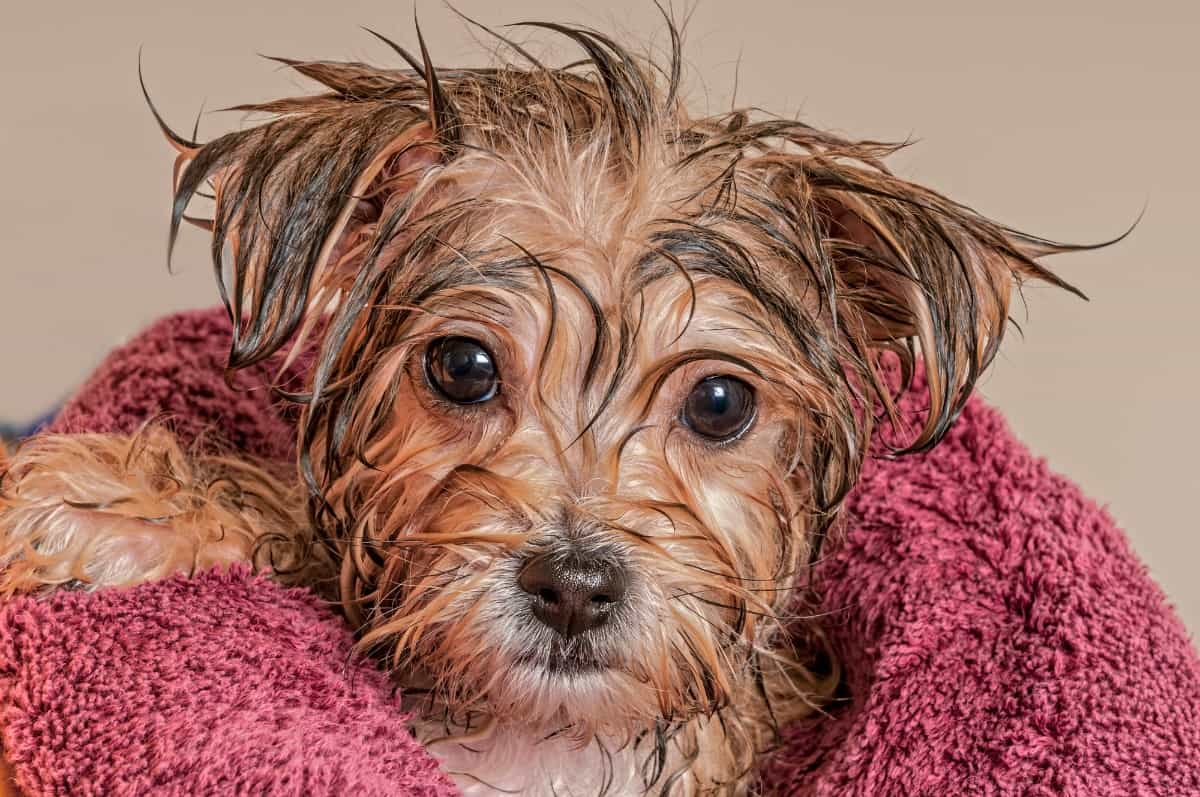
FAQ's about Bathing a Puppy
Here are a few of the most common questions I get asked about puppy bathtime:
How old should a puppy be to get a bath?
Very young puppies don't generally get very dirty, and it's best not to bathe them before they're 7 - 8 weeks old if possible.
This is because for the first month or so, puppies can't regulate their own body temperature, and they (especially toy and tiny breeds) can get chilled pretty quickly... so a puppy bath is not a good idea during that time, and a quick 'sponge bath' is much better, and safer.
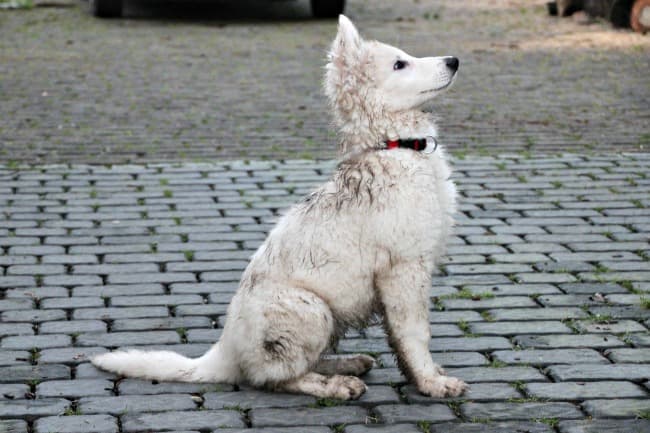
How often can i bathe my puppy?
There really isn't just one answer to this question because how often you give your puppy a bath depends on a lot of different things such as weather, breed, lifestyle etc.
How long little Fido spends outside and whether it's wet, muddy winter or warm, dry summer factor in.
Breed and coat type also plays a role. When all external criteria are equal, water repellent coats (eg. the Labrador, Newfoundland, Great Pyrenees) tend to need fewer baths, while curly coated dogs such as Poodles and Doodles for example, need the most.
Then there's the occasional crisis - perhaps she's been happily rolling in dead Armadillo (I can personally vouch for the immediate and critical need for a bath, no several, consecutive baths in that case!).
Bottom line - if your pup is dirty, smelly, sticky ...or all of the above then puppy bath time is definitely in order.
Weekly baths are rarely necessary, but monthly, bi-monthly or bi-yearly puppy bath time schedules are all totally acceptable.
But keep in mind that less can also be more because over bathing can cause dry, irritated skin, so keep an eye on little Fido's coat and skin to make sure that doesn't happen.
Can i give my puppy a bath after spay/neuter surgery?
The answer to this is 'Yes, but not right away'.
It's natural to want to clean your puppy up after she's had surgery BUT, you don't want to get any new incision wet or it could cause a problem, such as an infection.
Veterinarians usually advise waiting 10 - 14 days after a spay/neuter surgery (and until the stitches have dissolved or been removed) before bathing your puppy.
tip....tip...tip...
Even if your puppy isn’t especially dirty, it’s not a bad idea to give him a bath now and then because little Fido needs to get familiar with the feeling of the water, being shampooed and blow dried etc. so that he won't be scared of the whole process later on.
It's one thing trying to give a nervous puppy a bath... but quite another to try the same thing with a 75lb adult dog!
Puppy Bath Time Prep!
Although bathing a puppy isn't rocket science, knowing what you need and which steps to take to get your furbaby clean without a lot of fuss will make the whole process easier.
So, first things first... and the first step is preparation
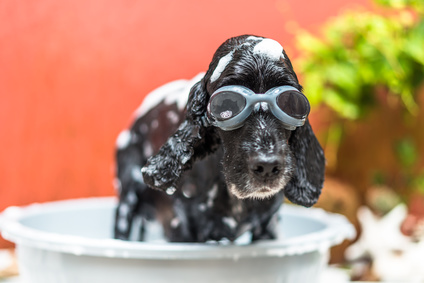
be prepared
You’ll want to prepare the location ahead of time, and also to have everything you need close to hand.
Having to search frantically for the shampoo when your puppy is already soaking wet and slippery as an eel is not fun. Prepping beforehand makes for a less stressful experience for everyone.
Some puppies take to baths like ducks to water, others aren't too sure about it at all. For anxious puppies having a favorite toy or a peanut-butter covered lick mat on hand can help.
Using slow movements and a low, calm voice helps every puppy, nervous or not. You can make bath time as quick as is practical if little Fido isn't a fan, but don't move fast or rush. That will only make him more anxious.
what time of day should i bathe my puppy?
It really doesn’t matter too much when you
give your pup his bath (and if you’re doing it because he got muddy, or poop in
his fur, or whatever then you just do it as needed), but if you have a choice
then bathing a puppy in the morning, or at least before lunchtime, is usually
my first choice.
The late afternoon/evening hours are often a time when puppies are over stimulated, over tired and just downright ornery, so not an ideal time for a bath because the experience can be stressful for them at first and they’re not necessarily in the right frame of mind to co-operate! Plus having a morning bath gives them a chance to get fully dry before evening/bed time.
where should I bathe my puppy?
Obviously somewhere with running water is key, plus if it’s got a tile or easy to dry floor that’s a plus. A bathroom, laundry room or kitchen is usually the best choice.
Depending on the size of your puppy you can either use a sink, or the bathtub or choose a dog/puppy bath tub (you can get ones like this which fit inside the sink or bathtub, or ones which can be set up independently inside or outside (this is an example). There are all different styles and sizes and something to fit every dog or situation.
Wherever or whatever you choose, be sure the surface is non-slip by adding a mat to a sink or tub. That will help Fido feel more secure and obviously makes it safer for him by preventing him from slipping or falling.
For active, wriggly pups or those that might be anxious about the whole thing, keeping their collar on and attaching a light leash isn't a bad idea. It helps you stay in control a little more easily.
what supplies do i need for puppy bath time?
Gather up all the necessary supplies before you fill the tub. You don’t need a lot of stuff, the basics include:
- Puppy-safe shampoo
- Coat detangler/conditioner (if your puppy has long, curly or thick coat)
- Washcloth
- Two towels (appropriately sized for your puppy)
Rinsing will be easier if you have a large jug close at hand, or a hand-held shower attachment for the faucet.
If you are using a shower head you will still want either a small jug or a beaker to mix shampoo and water together.
A hair dryer set on cool, or a dog-specific dryer can be helpful. Also, make sure you’re protected by a large apron, or wear old clothes, because chances are you’re going to get wet!
Some puppies can get wriggly once in the tub, so having something to keep his attention can make the whole thing easier.
Lick mats are awesome for this. If you don’t have one on hand you can simply smear peanut butter onto the side of the tub, sink or shower in a pinch.
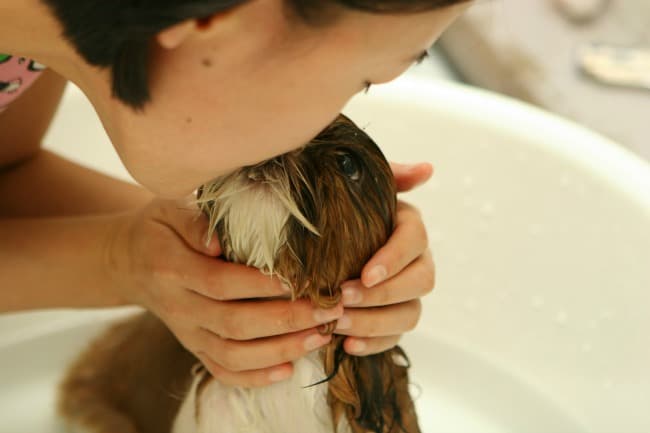
You want to use a shampoo that has been specifically formulated for puppies as adult dog shampoo, or human shampoo, is too harsh for their delicate skin. Don't use a flea or medicated shampoo as these can be unsafe for puppies.
I prefer natural products with as few artificial ingredients as possible. . Burt's Bees tearless 2-in-1 Puppy Shampoo and We Love Doodles Puppy Shampoo & Conditioner are both good choices (and no, your pup doesn't have to be a doodle to use the latter!).
Colloidal oatmeal shampoo and conditioner is also gentle and soothing on your puppy skin and coat, even the adult versions
got a large breed puppy?
If your puppy is of a large, X-large or giant breed, you might also want to consider training your little one to walk into the shower stall instead of getting in the tub at some point.
.It’s pretty simple to get him familiar with walking into a shower stall while he’s young, and small enough to handle easily. One of my sons does this with his Pitbull Terrier and it works perfectly.
Your Guide to Giving a Puppy a Bath
Okay, so you’ve got everything lined up and you’re ready to go, so let’s get started.
I’d suggest running the water into the tub/sink before you bring your puppy into the room so that he doesn’t get spooked by it. You only need a few inches of warm water, if you make it so that the water comes approximately up to your puppy’s knees that’s about right.
Temperature wise you want it to be somewhere around 37-38 Celsius/97-100F. If you don’t have a thermometer just dip your elbow into the water, if it feels comfortably warm but not hot then it’s good.
You can remove your pup’s collar or keep it on (that plus a light leash can help you keep hold of a very wriggly puppy) but after the bath don’t forget to remove it and let it dry thoroughly before putting it back onto your pup.
Place some cotton balls in her ears to protect them from having water enter the ear canal which can cause inflammation or even infection later.
A few drops of mineral oil, a lubricating dog eye ointment or even just a light smear of Vaseline can help prevent the shampoo from irritating your puppy’s eyes too.
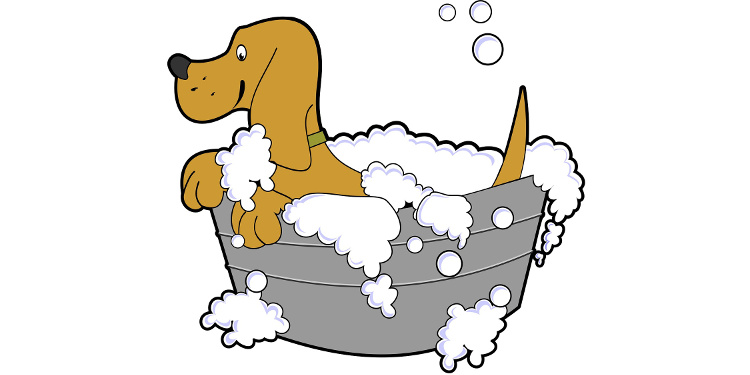
- Slowly and gently ease your puppy into the water, talking calmly and soothingly to him as you do it. Keep telling him he’s a good boy and talking to him gently and happily throughout the bath as this will help him associate it with kind words and love.
- Use a jug or shower head to soak his coat. Get it wet all the way to the skin. Some types of coats are very water resistant so this may take a few tries to accomplish.
- Mix a little of your chosen shampoo with water in a jug (or beaker if you’re using a shower head) and pour it over your puppy starting at the neck and moving down towards the tail.
- Lather well, avoiding the eyes and ears.
- Use a warm, slightly soapy washcloth to clean his face.
- Rinse thoroughly. This is an important step. Any soapy residue left on little Fido’s coat or skin can cause irritation later, leading to scratching and discomfort long after the bath is over.
- If your puppy has a long, thick or curly coat, a detangler or conditioner can be helpful and prevent tangles and snarls later. If you use this make sure to rinse it out fully too.
- Drain water from sink or tub. Gently squeeze as much water as you can from your puppy’s coat.
- Remove the cotton balls from his ears
- Put one towel on the floor beside the tub, lift Fido out of the water and put him on the towel. Then stand back… because your puppy is going to shake himself, hard. Maybe several times. Let him do this if you can, as it will get rid of a surprising amount of water and make it easier to dry him with the second towel.
- Wrap him in the dry towel and remove as much of the remaining water as you can.
- Check his ear canals for water and dry gentle with a dry washcloth or cotton pads if necessary. Never use Q-tips or try to push anything beyond the open part of the ear into the canal.
- Give your little guy tons of praise, hugs and some tasty treats once at this point. He deserves them.
Let Fido finish drying off in a warm environment, or use a doggie hair dryer. Using a human hair dryer isn’t recommended but if you use low/cool settings it can be okay, just be very careful not to burn or hurt your pup’s delicate skin.
Although this might seem like a good time to trim your puppy’s nails I’d suggest that you leave that for another time. For puppies new to bath time it can be a tiring and anxiety-inducing situation, and adding the stress (and trickiness) of nail trimming isn’t necessarily a good idea.
A quick brush once his fur is almost dry can help make him look neat and tidy, but it’s not essential.
Keep an eye out for any signs of discomfort or skin irritation for the first few days post-bath, especially when it’s a new experience. Itching, redness, or dry patches could mean you need to try different bathing products, or take extra care during the drying phase.
tip... tip... tip...
If you don’t want to get soaked by your puppy shaking himself there’s a trick you can use to minimize it.
A dog’s ‘shake’ starts at the tip of the nose and works all the way down to the tip of the tail. So when you see that shake is about to start you can gently hold his muzzle still and head off, or at least minimize, the severity of the shaking.
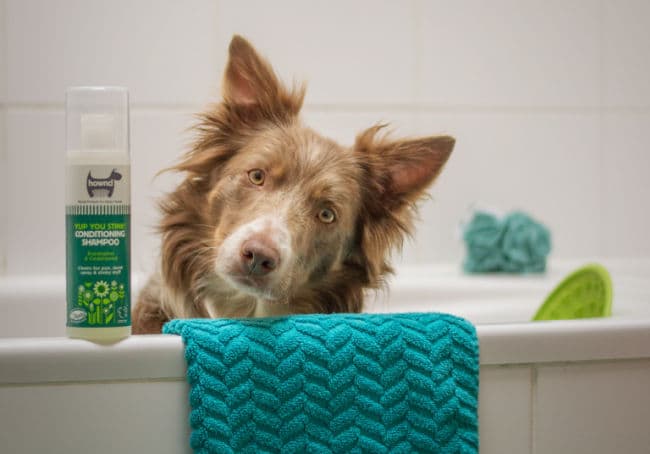
Puppy Bath Touch Ups & Time Savers
If you're in a hurry to get your puppy all clean and sweet-smelling but don't have enough time for the full bath time routine, there are a whole range of products that can help, whether it's eyes, ears, paws or the whole kit and caboodle.
Here are a few suggestions:
- Burt's Bees waterless dog shampoo
- Pogi's hypoallergenic dog grooming wipes
- Buddy Muddy dog paw cleaner
- Pet MD dog ear cleaner wipes
- Angel Eyes tearstain remover wipes
If your pup/dog has white fur and you struggle to keep his eye area white then Angels' Eyes Tear-Stain Eliminator for Dogsmight be just what you need. It works 'from the inside out' to eliminate those unsightly stains.
Simply sprinkle some of this dietary supplement on your puppy's
food daily and soon her little face will be clean and her eyes bright. We use it on our Olde English Bulldogge and it works like a charm!
you might also like...
- Home
- How to Groom a Dog
- Bathing a Puppy
FTC Disclosure: Some pages on this site contain affiliate links. I may earn on qualified purchases.
